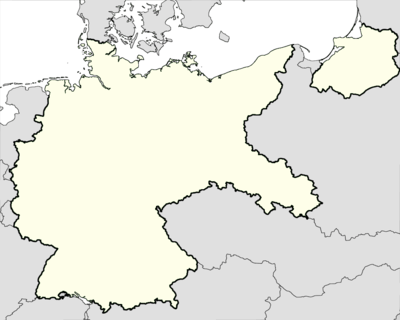Stalag IX-B
| Stalag IX-B | |
|---|---|
| Bad Orb, Hesse | |
 Stalag IX-B | |
| Coordinates | 50°12′36″N 9°23′52″E / 50.21009°N 9.39789°E |
| Type | Prisoner-of-war camp |
| Site information | |
| Controlled by |
|
| Site history | |
| In use | 1939 – 1945 |
| Garrison information | |
| Occupants | Allied POW |
Stalag IX-B (also known as Bad Orb) was a German World War II prisoner-of-war camp located south-east of the town of Bad Orb in Hesse, Germany. It had the reputation of being one of the worst Stalags, especially when it was overcrowded in 1945. The camp was also the site of the segregation and removal of Jewish-American troops who, once identified, were transferred to the labor camp at Berga.
Camp history
The camp was originally established by the German Army during World War I, and in the 1920s the barracks were converted to a summer camp for children.[1]
In December 1939 it was again taken over by the Army and used to house Polish prisoners sent to work in the area, especially the salt mines. They were joined in June 1940 by French taken prisoner during the Battle of France, and in 1941 Yugoslavian prisoners arrived from the Balkans Campaign, mainly Serbs. In 1942 the first Soviet prisoners arrived at the camp, and in 1943 after the armistice, Italian prisoners arrived. Finally, in late December 1944, Americans captured in the Battle of the Bulge arrived. One of these was Lt. Donald Prell, Anti-Tank Company, 422nd Inf., 106th Division. After having been interrogated and assigned a POW number he was transferred to Oflag XIII-B. Approximately 4,700 U.S. infantrymen were held there,[2] far exceeding the capacity of the camp and resulting in very severe overcrowding, even after their officers and NCOs were later transferred to other camps.

In January 1945 the commandant ordered all Jewish prisoners to step forward out of the daily line-up. At first none did. But after being kept standing for several hours 130 came forward. However the commandant had been requested to provide 350 for the transport.[3] Troublemakers, including PFC J.C.F. "Hans" Kasten, the elected camp leader (born in Hawaii of German-American parents), were then selected, including anyone who "looked Jewish". The group was taken by train to the Berga labor camp.[4]
The camp was liberated by a task force comprising the 2nd Battalion, 114th Regiment, U.S. 44th Infantry Division, reinforced with light tanks and armored cars from the 106th Cavalry Group and 776th Tank Destroyer Battalion. On 2 April 1945 the task force broke through the German lines and drove north over 60 km (37 mi) through enemy held territory to Bad Orb and liberated Stalag IX-B.[5]
Post-war the camp was used as a camp for refugee and displaced Germans until 1969, when it reverted to its pre-war role as a camp for children. It currently operates under the name Schullandheim Wegscheide.[6]
Berga labor camp
The 350 selected men traveled in locked boxcars, without food or water, for four days before arriving at labor camp Berga, located in eastern Thuringia 12 km (7.5 mi) south of Gera. The camp was under the command of Lt. Hack and was a slave labor camp, contrary to the rules of the Third Geneva Convention. The POWs were put to work, together with inmates of the Buchenwald concentration camp, digging 17 tunnels for an underground ammunition factory, some of them 150 feet below ground. As a result of the appalling conditions, malnutrition and cold, as well as beatings, 47 prisoners died.[7] The U.S. military authorities never acknowledged the incident.
On 4 April the 300 surviving American prisoners were marched out of the camp ahead of approaching American troops. After a 2½-week forced march they were finally liberated. During this march another 36 Americans died.
Prisoner escape
During an air-raid, while the camp lights were extinguished, Hans Kasten, Joe Littel and Ernst Sinner, wriggled under the wire and escaped from the Berga. Their freedom lasted only a few days. Trying to get food at the inn of a small town, they were arrested and taken to Gestapo headquarters. After identification as POWs they were taken to Buchenwald and placed in detention cells. Most likely they would have been killed like many other escaped prisoners (see Stalag Luft III and Oflag VI-B). Fortunately for them Buchenwald was soon liberated by the U.S. Army.[4]
See also
References
- ↑ Hirschmann, Hans (June 2007). "Frankfurter Schulen 1933-1945 Orte der Ausgrenzung" (PDF). Freundeskreis der Auschwitzer Newsletter (in German) 27 (1): pp.18–28. Retrieved 20 May 2012.
- ↑ Uhl, John (2012). "Berga - Soldiers of Another War : Prisoners of War Camps". PBS. Retrieved 20 May 2012.
- ↑ Bard, Mitchell G. (1996). Forgotten Victims: The Abandonment of Americans in Hitler's Camps. Boulder, Colorado: Westview Press. ISBN 0-8133-3064-5. Retrieved 20 May 2012.
- ↑ 4.0 4.1 Kasten, J.C.F. "Hans" (2012). "Personal Narrative: Johann Carl Friedrich Kasten IV". Library of Congress : Veterans History Project. Retrieved 20 May 2012.
- ↑ "Stalag IX Liberation". 44th Infantry Division History. 2010. Retrieved 20 May 2012.
- ↑ "Schullandheim Wegscheide". schullandheim-wegscheide.de (in German). 2012. Retrieved 20 May 2012.
- ↑ Uhl, John (2012). "Berga - Soldiers of Another War : Berga and Beyond". PBS. Retrieved 20 May 2012.
External links
- The Lost Soldiers of Stalag IX-B The New York Times Magazine (subscription required)
- "Stalag IX-B in Bad Orb, Germany". lonesentry.com.